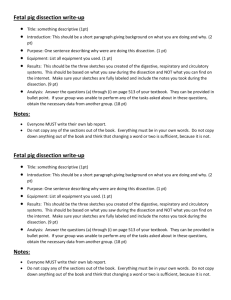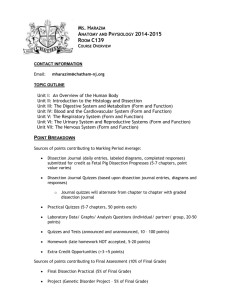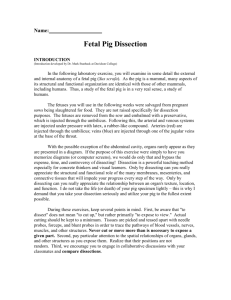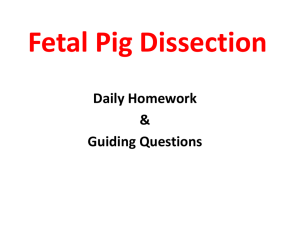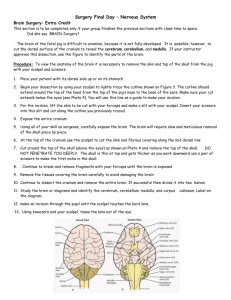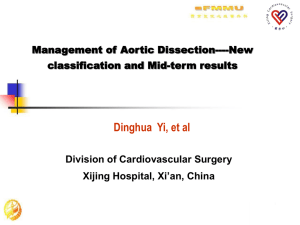Activity 4.2.3 Inside Investigation
advertisement
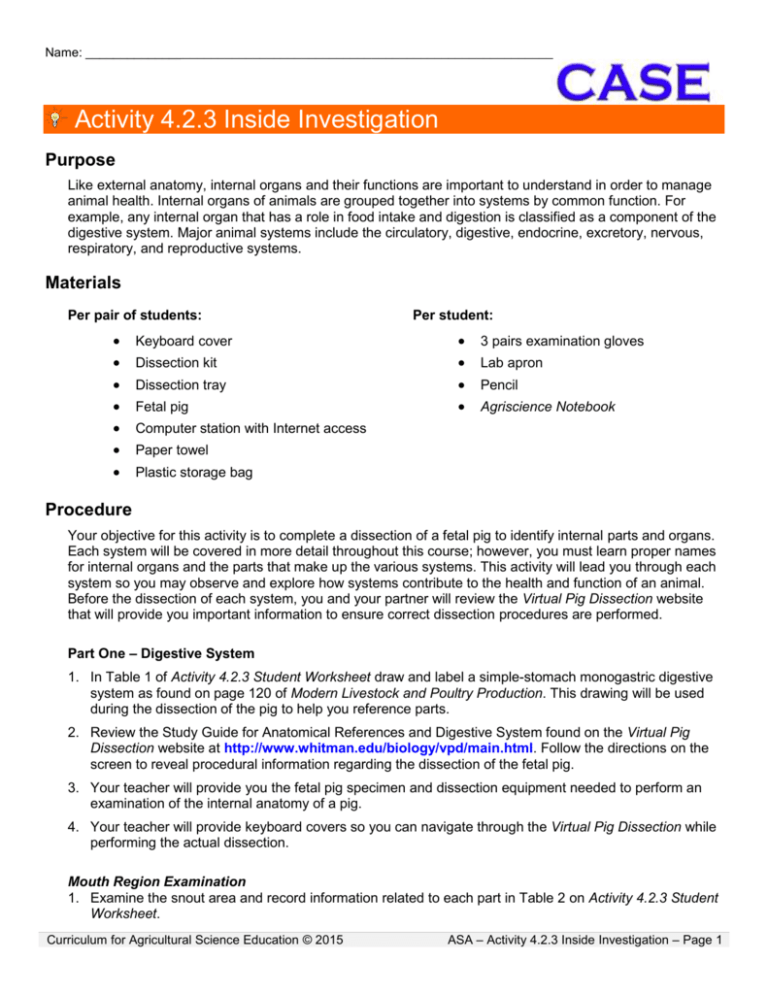
Name: ___________________________________________________________________ Activity 4.2.3 Inside Investigation Purpose Like external anatomy, internal organs and their functions are important to understand in order to manage animal health. Internal organs of animals are grouped together into systems by common function. For example, any internal organ that has a role in food intake and digestion is classified as a component of the digestive system. Major animal systems include the circulatory, digestive, endocrine, excretory, nervous, respiratory, and reproductive systems. Materials Per pair of students: Keyboard cover Dissection kit Dissection tray Fetal pig Per student: 3 pairs examination gloves Lab apron Pencil Agriscience Notebook Computer station with Internet access Paper towel Plastic storage bag Procedure Your objective for this activity is to complete a dissection of a fetal pig to identify internal parts and organs. Each system will be covered in more detail throughout this course; however, you must learn proper names for internal organs and the parts that make up the various systems. This activity will lead you through each system so you may observe and explore how systems contribute to the health and function of an animal. Before the dissection of each system, you and your partner will review the Virtual Pig Dissection website that will provide you important information to ensure correct dissection procedures are performed. Part One – Digestive System 1. In Table 1 of Activity 4.2.3 Student Worksheet draw and label a simple-stomach monogastric digestive system as found on page 120 of Modern Livestock and Poultry Production. This drawing will be used during the dissection of the pig to help you reference parts. 2. Review the Study Guide for Anatomical References and Digestive System found on the Virtual Pig Dissection website at http://www.whitman.edu/biology/vpd/main.html. Follow the directions on the screen to reveal procedural information regarding the dissection of the fetal pig. 3. Your teacher will provide you the fetal pig specimen and dissection equipment needed to perform an examination of the internal anatomy of a pig. 4. Your teacher will provide keyboard covers so you can navigate through the Virtual Pig Dissection while performing the actual dissection. Mouth Region Examination 1. Examine the snout area and record information related to each part in Table 2 on Activity 4.2.3 Student Worksheet. Curriculum for Agricultural Science Education © 2015 ASA – Activity 4.2.3 Inside Investigation – Page 1 2. Make the jaw incision and examine the salivary gland. Record information in Table 2. 3. Make the oral cavity incision and record information related to these parts in Table 2. Abdominal Cavity Examination 1. Make a very shallow cut with the scalpel to peel back the skin layer as seen in the Virtual Pig Dissection instructions at http://www.whitman.edu/biology/vpd/main.html. Record information related to visible muscles at this step in Table 3 on Activity 4.2.3 Student Worksheet. 2. Cut through the peritoneal membrane and remove the liver. 3. Remove the digestive organs as viewed on the website from the body cavity and set aside. 4. Replace the liver back into the abdominal cavity. 5. Moisten a paper towel with water, place it in the body cavity, and fold the skin flaps back over the abdominal cavity. 6. Place pig in a plastic bag and label the bag with your name. Your teacher will instruct you were to store the bag for a later dissection. 7. Clean all dissection tools as specified by your teacher and return them to the proper storage location. 8. Provide the requested information for Table 3. 9. Your teacher will come to your station and have you identify the digestive parts that you have removed. After your teacher has quizzed you, discard these parts in the proper place as directed by your teacher. Part Two – Circulatory and Respiratory Systems 1. Review the Study Guide for Circulatory and Respiratory Systems found on the Virtual Pig Dissection website at http://www.whitman.edu/biology/vpd/main.html. Follow the directions on the screen to reveal procedural information regarding the dissection of the fetal pig. 2. Retrieve your fetal pig from storage and dissection equipment needed to perform a further examination of the internal anatomy. Remember to use keyboard covers so you may navigate through the Virtual Pig Dissection on the computer while performing the actual dissection. 3. Remove the paper towel and the liver from the abdominal cavity. 4. Make an incision on the upper chest area as shown in the Virtual Pig Dissection Study Guide for the circulatory system. 5. Locate the parts shown in the study guide and remove the heart and lungs. 6. Dissect the heart as shown in the study guide and locate the ventricles, atriums, and aorta. 7. Answer the questions related to the circulatory system in Table 4 on Activity 4.2.3 Student Worksheet. 8. Open the respiratory study guide of the Virtual Pig Dissection website. 9. Make an incision in the throat area to expose the trachea and upper respiratory system. 10. Answer the final questions related to the respiratory system in Table 4. 11. Clean up your dissection equipment and return it to the storage area. 12. Replace the liver and moisten a paper towel. Insert the liver and damp paper towel in the abdominal cavity and store your fetal pig as you did in Part One. 13. Your teacher will have you identify the circulatory and respiration parts that you have removed. After your teacher has quizzed you, discard these parts in the proper place as directed by your teacher. Curriculum for Agricultural Science Education © 2015 ASA – Activity 4.2.3 Inside Investigation – Page 2 Part Three – Excretory, Reproductive, and Nervous Systems 1. You will access Virtual Pig Dissection website at http://www.whitman.edu/biology/vpd/main.html and review the Study Guide for Excretory System, Sexing Your Pig, Reproductive System, and Nervous System. 2. Retrieve your fetal pig from storage and dissection equipment needed to perform further examination of the internal anatomy. 3. Remember to use keyboard covers so you may navigate through the Virtual Pig Dissection on the computer while performing the actual dissection. 4. Remove the paper towel and the liver from the abdominal cavity. 5. Remove the kidneys and make an incision to see the internal structures as shown in the excretory system study guide. 6. Complete the incisions for the reproductive system and locate the structures shown in the reproductive system study guide for the gender of your pig. 7. View the nervous system study guide and try to expose the brain without causing it damage. This dissection procedure is extremely difficult and if you damage the brain in doing so, you will need to follow the study guide illustrations for your information. 8. Answer the questions related to the excretory, reproductive, and nervous systems in Table 5 on Activity 4.2.3 Student Worksheet. 9. Clean up your dissection equipment and return it to the storage area. 10. Your teacher will have you identify the excretory, reproductive, nervous system parts that you have removed. After your teacher has quizzed you, discard these parts and the remains of the fetal pig in the proper place as directed by your teacher. Conclusion 1. Explain how the systems dissected in this activity overlap in terms of shared functions or characteristics. 2. How are the kidneys and the liver similar in terms of function? 3. Describe the path including the proper names of the digestive system parts that food will travel as it enters through the mouth of an animal and travels out through the rectum. Curriculum for Agricultural Science Education © 2015 ASA – Activity 4.2.3 Inside Investigation – Page 3 Name: ___________________________________________________________________ Activity 4.2.3 Student Worksheet Table 1. Simple-stomach Monogastric System Table 2. Mouth Region Parts Question Response What is the purpose of nostrils? What muscular structure is used to aid eating? What is the proper term for taste buds? Where are the salivary glands located? What are the two types of palates? Where is the location of tusks? What is the junction of the passageways for food and air called? What is the function of the epiglottis? Curriculum for Agricultural Science Education © 2015 ASA – Activity 4.2.3 Inside Investigation – Page 4 Table 3. Digestive Parts from Abdominal Region Question Response List the three muscles found under the skin in this dissection. What is the name of the membrane that holds the organs in the abdominal cavity? What is the length of the small intestine? Explain the function of the large intestine. What organ secrets bile, which is a substance to aid in the digestion process? Describe the purpose of the spleen. What is the role of the pancreas? Signature of Teacher’s Approval for Part One Table 4. Circulatory and Respiratory Systems Question Response Describe the position of the heart in relationship to the lungs. List the four parts to the heart. Why are the left ventricle walls thicker for an adult pig? List the parts of the respiratory system in the order air moves from the nose to the alveoli. What is the purpose of the diaphragm? Signature of Teacher’s Approval for Part Two Curriculum for Agricultural Science Education © 2015 ASA – Activity 4.2.3 Inside Investigation – Page 5 Table 5. Excretory, Reproductive, and Nervous Systems Question Response What is the sex of your pig? Define excretion. List the four parts of the excretory system shown in the study guide. List the three parts of the male reproductive system shown in the study guide. List the three parts of the female reproductive system shown in the study guide. List the four lobes of the brain and describe what each lobe does. What structure provides the spinal cord protection? Where is the lumbar region on an animal? Signature of Teacher’s Approval for Part Three Curriculum for Agricultural Science Education © 2015 ASA – Activity 4.2.3 Inside Investigation – Page 6
